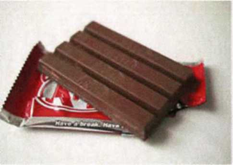15 dec 2016
Uitspraak ingezonden door Gregor Vos, Brinkhof.
Gerecht EU: Kit Kat-vormmerk opnieuw naar EUIPO voor inburgeringsbewijs

Gerecht EU 15 december 2016, IEF 16453; IEFbe 2031; ECLI:EU:T:2016:735 ; T-112/13 (Kit Kat) Merkenrecht. Het HvJEU [IEF 15255] weigerde eerder het vormmerk vanwege de technische uitkomst. Het Gerecht EU vernietigt de EUIPO-beslissing [IEF 12171]. Van de inzender:
De beslissing bespreekt zeer uitgebreid wat er nodig is voor inburgering van een merk en wijst o.m. de archaïsche, onnodig ingewikkelde en vooral onjuiste Engelse ‘reliance’ leer af. Alle juridische bezwaren van Mondelez worden afgewezen, wat mooi is voor KitKat en merkhouders in het algemeen. Wel verwijst het Gerecht de zaak terug naar de Kamer van Beroep om het inburgeringsbewijs van 4 lidstaten die het buiten zijn beslissing had gehouden [België, Ierland, Griekenland en Portugal], alsnog te beoordelen. Wordt dus nog vervolgd.
59 Lastly, it is true that it follows from the analysis carried out by the Board of Appeal that the proof of acquisition of distinctive character through use of the contested trade mark is based, to a large extent, on the identification of the commercial origin by making reference to the product known as ‘Kit Kat 4 fingers’ and, hence, to the word mark KIT KAT. However, as the Board of Appeal correctly observed in, inter alia, paragraphs 63 to 70 of the contested decision, each of the surveys examined showed that, when only the shape of the product in question was shown to respondents, a considerable percentage of them spontaneously and immediately associated that shape with the word mark KIT KAT or the intervener.
60 Consequently, in the contested decision, the Board of Appeal relied, for the purposes of verifying whether the contested trade mark had acquired distinctive character, on the use of that trade mark in conjunction with, inter alia, the word mark KIT KAT.
144 However, even though the Board of Appeal erred in setting out the assessment criterion for proving distinctive character acquired through use of a mark throughout the European Union, it cannot be excluded that it applied it correctly when examining the evidence submitted by the intervener.
173 In that regard, it must be pointed out that the Board of Appeal did not explicitly answer the question whether it had been established that the contested trade mark had acquired distinctive character in Belgium, Ireland, Greece and Portugal. However, it is apparent from a combined reading of paragraphs 83 and 88 of the contested decision that those territories were not included among those of the Member States in respect of which the Board of Appeal considered that it had been established that the intervener was identified as the commercial origin of the product having the shape of the contested trade mark.
176 Consequently, the Board of Appeal erred in concluding, in paragraph 92 of the contested decision, that the intervener had shown that the contested trade mark had acquired distinctive character through use in the European Union, given that it had shown such distinctiveness only in a substantial part of the territory of the European Union, as had been stated in paragraph 90 of that decision.
177 Although it had been established that the contested trade mark had acquired distinctive character through use in Denmark, Germany, Spain, France, Italy, the Netherlands, Austria, Finland, Sweden and the United Kingdom, the Board of Appeal could not validly conclude its examination of the distinctive character acquired by the contested trade mark throughout the European Union on the basis of the percentage of the public recognising that mark in those Member States, even if the population of those states represented almost 90% of the population of the European Union, without coming to a conclusion regarding the perception of the mark by the relevant public in, inter alia, Belgium, Ireland, Greece and Portugal and without analysing the evidence adduced in respect of those Member States.
178 In those circumstances, the Board of Appeal erred in law in concluding, in paragraph 92 of the contested decision, that the contested trade mark had acquired distinctive character through the use that had been made of it in the European Union and that it could not be declared invalid for having been registered in breach of Article 7(1)(b) of Regulation No 207/2009.
179 Having regard to all of the foregoing, the first plea in law must be upheld and the contested decision must be annulled. It is unnecessary to examine the second and third pleas in law relied on by the applicant.


























































































